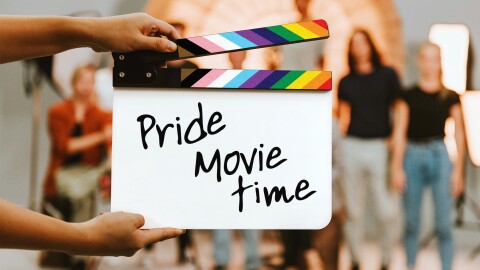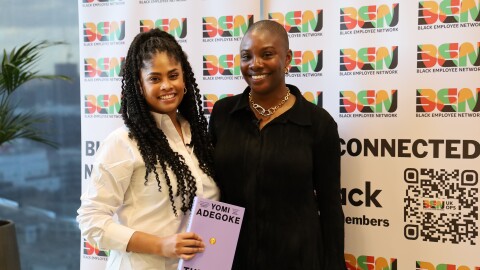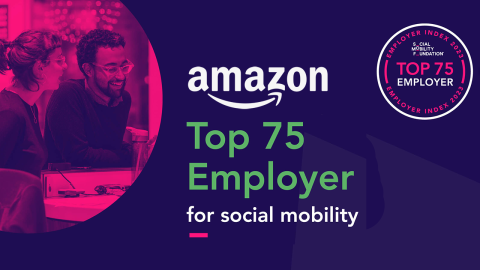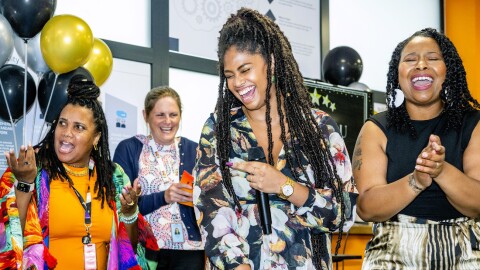We celebrated Global Accessibility Awareness Day by creating a month-long programme of talks, training and thought leadership throughout May. Activities included talks from Special Effect and Open Inclusion, plus free cake for attendees and guest spots for disabled speakers to discuss the impact of universal design.
To find out more about accessible design at Amazon, we spoke to Suzie Miller, Solutions Architect for Amazon Web Services and Chair of Amazon’s People With Disabilities.

Tell us about your role at Amazon
I’m a Solutions Architect for Amazon Web Services – a varied role that involves helping companies with their web and cloud services. We help companies to design the right web architecture for their business, so they can focus on building incredible products.
And I’m proud to be Chair of People With Disabilities for Amazon in the UK, where we help employees and customers with awareness, accessibility and career aspirations.
Living with ‘invisible’ disabilities myself, it’s great to work for a company that embraces diversity and difference. Early in my career here, an internal course opened my eyes that I could be myself in the office and that they would be supportive when I needed flexibility.
Accessibility and disability: what’s the big picture?
It’s important to understand that disability comes in many different forms and no individual has full capability for every activity throughout their life. Disability can affect any of us.
The World Health Organisation estimates that more than a billion people live with some form of disability and the European Commission estimates that 80 million EU citizens live with a disability. This figure is expected to increase to 120 million by 2020 due to the aging population.
In the UK alone, the combined spending power of British families with at least one disabled person is estimated to be more than £249bn per year.
These figures illustrate the wide impact and variety of disability.
What do we mean by ‘accessible design’?
Dropped kerbs are an obvious example. They were introduced following the Second World War to help those who returned in wheelchairs or on crutches, but we realised that they’re useful for bikes, buggies, trolleys and all sorts of other things.
Subtitles are another example of accessibility that can benefit all users. Although they’re intended for people with hearing loss, they can also be useful if you’re on the train, browsing social media on the move or watching a film in a foreign language.
In a digital environment, examples include screen readers, features to adjust font size and the use of special colour palettes to cater for the colour blind.
Why is accessible design important at Amazon?
Being customer obsessed means making our products as accessible as possible. By considering accessibility from the outset, we can avoid ‘locking out’ anybody and create a more inclusive experience.
Businesses also risk missing out on unique expertise if they overlook the skills, perspectives and experiences of those living with disabilities as potential employees.
It’s important to understand that ‘universal’ accessibility is our ambition – however that is not always achievable due to the wide variety of disability. By taking accessibility into account from the start of a new project, we can ensure our products are as accessible as possible. And we continually adapt our existing products for optimal accessibility.
What are your top tips for developers about accessible design?
Start with the Web Content Accessibility Guidelines (WCAG). It’s important to remember that these are guidelines, not rules, so they can be interpreted as a benchmark which developers should aspire to. It’s also important to be realistic about what is achievable.
- WCAG guidelines include the use of tags for headers and sub-headers, which help people using screen readers. However, remember that dyslexic people also use screen readers, not just those with vision problems, so there are broad benefits in using headers and sub-headers.
- Alt Text (when an image has an Alt Tag attribute that describes the content of the picture) is another important area. Screen readers are reliant on these to help the visually impaired know what an image is or what a button does e.g. ‘search’ or ‘buy now’. Search engine results also take Alt Text tags into account, so you could be missing out on traffic without them!
- Colour checkers help designers check that they’re working with high contrast colours, which can also help people using bad monitors or those trying to read content on their phone in sunny weather.
For designers and developers, it’s also worth checking out Amazon Polly, a text-to-speech service that can be incorporated into products. Amazon Transcribe can add captions to video content, and we also provide an AWS Solution for Live Streaming with Automated Multi-Language Subtitling, which automatically generates multi-language subtitles for live streaming video content in real time.
To find out more about Amazon’s People With Disabilities in the UK, please click here.











